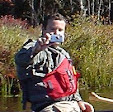 |
| Rolling Dam |
The Blackstone River arises in Worcester and flows south for 48 miles, eventually becoming the Seekonk River at the Pawtucket Falls. Native Americans called the river the "Kittacuck", which meant "the great tidal river." Salmon and other migratory fish were plentiful in pre-colonial times.
 |
| Blackstone Gorge below Rolling Dam |
The Blackstone River drops 438-feet in elevation on its way from Worcester to Providence. Early settlers built dams to power sawmills and gristmills to serve the needs of area farmers. With the coming of the Industrial Revolution, the river's steep drop and numerous falls provided ideal conditions for the development of small, rural textile mills around which mill villages developed. Much of this early history can be seen along this section of the river.
 |
| Launching above Rolling Dam |
We put in above the dam and headed upstream. We had 8 boats – 7 kayaks and one canoe. The river was a little low - 3.1 feet on the Northbridge gage, 6.6 feet, 78 cfs on the Rt. 122 gage. Paddling upstream from the dam is always a pleasant trip, and the foliage was just about peak. We paddle up to the Triad Bridge site.
 |
| Heading upstream |
On this site, three bridges were planned to allow three different railroads to cross the Blackstone River. The lowest, the Providence & Worcester, is still in use. The middle, the New York & New England that was eventually owned by J.P Morgan, has now been converted to the bike path bridge. The top, the Grand Trunk Line, was never completed.
 |
| Triad Bridge Site |
Just upstream from the Triad Bridge site is the Millville Lock – one of two remaining locks from the 1828 Blackstone Canal. The other is the Goat Hill Lock at River Bend Farm. Opened in 1828, the Blackstone Canal utilized a series of 49 locks to move the barges up and down the 438-foot difference in elevation from Providence to Worcester.
 |
| Millville Lock |
We continued upstream into Millville below the Millville Rapid. Millville is one of the oldest, and one of the youngest towns in Massachusetts. Originally settled in 1662, it was organized as Mendon's South Parish in 1766, and became part of the town of Blackstone in 1845. It wasn't until 1916 that it was incorporated as an independent town.
 |
| Shallow water in Millville |
We tuned around in the shallow water below the Millville rapid and headed back downstream. Before we reached the dam, we turned left and followed the route of the Blackstone Canal into Blackstone. It later became the power trench for the Lonsdale Company’s Blackstone Mill.
 |
| The crew at the put-in |



